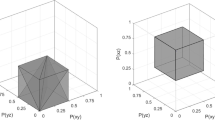Abstract
This paper reports the results of an experiment designed to uncover the stochastic structure of individual preferences over lotteries. Unlike previous experiments, which have presented subjects with pair-wise choices between lotteries, our design allowed subjects to choose between two lotteries or (virtually) any convex combination of the two lotteries. We interpret the mixtures of lotteries chosen by subjects as a measure of the stochastic structure of choice. We test between two alternative interpretations of stochastic choice: the random utility interpretation and the deterministic preferences interpretation. The main findings of the experiment are that the typical subject prefers mixtures of lotteries rather than the extremes of a linear lottery choice set. The distribution of choices does not change between a first and second asking of the same question. We argue that this provides support for the deterministic preferences interpretation over the random utility interpretation of stochastic choice. As a subsidiary result, we find a small proportion of subjects make choices that violate transitivity, but the level of intransitive choice falls significantly over time.
Similar content being viewed by others
REFERENCES
Barbera, S. and Pattanaik, P.K. (1983), Falmagne and the rationalizability of stochastic choices in terms of random orderings, Econometrica 54: 707–715.
Block, H.D. and Marschak, J. (1960), Random orderings and stochastic theories of response, in I. Olkin et al. (eds), Contributions to Probability and Statistics: Essays in Honor of Harold Hotelling, Stanford University Press, Stanford, California.
Camerer, C. (1989), An experimental test of several generalized utility theories, Journal of Risk and Uncertainty 2(1): 61–104.
Camerer, C. (1995), Individual decision making, in J. Kagel and A. Roth (eds), The Handbook of Experimental Economics, Princeton University Press, Princeton, New Jersey.
Camerer, C. and Teck-Hua Ho (1994), Violations of the betweenness axiom and nonlinearity in probability, Journal of Risk and Uncertainty 8: 167–196.
Falmagne, J.-Cl. (1978), A representation theorem for finite random scale, Journal of Mathematical Psychology 18: 52–72.
Hausman, J. and Wise, D. (1978), A conditional probit model for qualitative choice: Discrete decisions recognizing interdependence and heterogeneous preferences, Econometrica 46: 403–426.
Loomes, G., Starmer, C. and Sugden, R. (1991), Observing violations of transitivity by experimental methods, Econometrica 59: 425–440.
Machina, M.J. (1985), Stochastic choice functions generated from deterministic preferences over lotteries, Economic Journal 95: 575–594.
McFadden, D. (1974), The measurement of urban travel demand, Journal of Public Economics 3: 303–328.
Sopher, B. and Gigliotti, G. (1993a), Intransitive cycles: Rational choice or random error? An answer based on estimation of error rates with experimental data, Theory and Decision 35: 311–336.
Sopher, B. and Gigliotti, G. (1993b), A test of generalized expected utility theory, Theory and Decision 35: 75–106.
Author information
Authors and Affiliations
Rights and permissions
About this article
Cite this article
Sopher, Narramore Stochastic Choice and Consistency in Decision Making Under Risk: An Experimental Study. Theory and Decision 48, 323–349 (2000). https://doi.org/10.1023/A:1005289611789
Issue Date:
DOI: https://doi.org/10.1023/A:1005289611789




